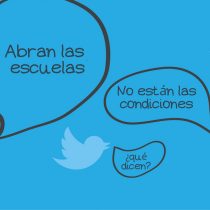
Twitter made its first appearance on July 15, 2006 and, since then, this social network that uses 280 characters has been characterized by the use of sarcasm, rabid attacks and sharp statements. This is probably what has led many cybernauts to use the term “honest question,” before raising any doubts – thus minimizing – the possibility of being targeted by ruthless lashed out.
These days, one of the main concerns that has garned attention on different social networks and media has related to the existence of real conditions to return, or not, to face-to-face classes this 2020. One thing is certain, the decision of when and how to make a return to schools will be one of the most difficult we will have taken as a Chilean education system.
But there is a third element, an even more complicated one and – on which – very little has been discussed: return to what?
Searching between hashtags and education-related tweets, we can see that the positions on an eventual reopening of schools are dicotomicly sketched. On the one hand, there are those who support the idea of ending the school year at a distance, arguing that there are no clear sanitary or regulatory conditions to return in person. On the other hand, there are those who promote return as soon as health conditions allow, understanding that, for many students in our country, the school emerges as the only space of containment, welcome and real shelter.
If there’s one thing this pandemic has taught us, it’s that no one was prepared for a crisis of this magnitude. The government was not, nor were the high schools, schools and schools of our country. There are no simple solutions that can be imitated to make a successful return, especially if we consider that international experience at this point shows results as diverse as they are contradictory.
But one thing is certain, the population and their organizations respond better when there is dialogue and trust. Elements that seem to fade each time binary positions on the issue of return are disqualified and adopted.
What is the point of creating artificial opposition between those who want to return to school and those who don’t? None! “You’re interested in coming back, because you’re only concerned about the activation of this unequal economic model,” said a furious tweeter. “Sure, you say there are no sanitary conditions because you’re comfortable at home, working less, tell the truth!” they would tell a teacher in the same tweet. Does this level of caricaturation bring dialogue and trust within communities to work on the issue of return? No, of course not. Even more so when there is a complete consensus that the school, being a place of socialization, learning and training of the future citizen subject, is an irreplaceable and extremely necessary space.
For various reasons, when and how it will be one of the most difficult decisions we will have to make. “Who will respond if a teacher, student, or education assistant dies? Are you going to respond?” the Minister of Education was asked at the special session of the chamber. And like these, there are many other questions, both complicated to answer. For example, will it be attractive for a school that already has a system installed with good rates of connection of its students, to play it for a mixed model from now on, how is the fluctuating attendance handled by students and the coverage of the prioritized plan in an eventual return?, how is it accompanied by a faculty that – surely – will arrive physically and emotionally worn? , how to tell a group of children, who have not seen each other in months, that they will not be able to play normally or exchange toys?
Probably, you and I, we could easily write 40 more questions. However, despite all of the above, there is a third element, one that goes beyond the logistics, regulations and strict protocols that must be applied sooner or later. That other question, more vital and necessary than ever.
A question that perhaps should occupy all the agendas and programmatic grills of what morning exists, but that does not. That question that should be retwed as the most important questioning of all: when we return to school, whether it’s four weeks, three months or a year: will we go back to what?
Difficult to answer that question, back to what? To what were we used to do? That is, to go back to that which made us “meaningful” before March 16, returning to that comfort zone that we had to leave abruptly because of the pandemic. Thus, resuming the logic of moving forward non-stop, with little or no real space for the development of other competences (those that we always said we did not have time to develop) to quickly retake the traditional ways of evaluating and qualifying?
It is for all of the above that I think we should return with a solid conviction: rethink our old practices, rethink and talk about what we used to do (which does not mean throwing out or burning everything, by the way). But in any way, we must be open to the possibility of questioning those beliefs that we thought were unimpunable. In other words, the way we taught and how our students learned. Because if at the time of returning, whenever this happens, we do exactly the same thing again, it is likely – very likely – we have learned absolutely nothing. And this, unfortunately, will show that we have missed an extraordinary opportunity and, perhaps, that goes about my honest question: if not now, when?
The content poured into this opinion column is the sole responsibility of its author, and does not necessarily reflect the editorial line or position of El Mostrador.





